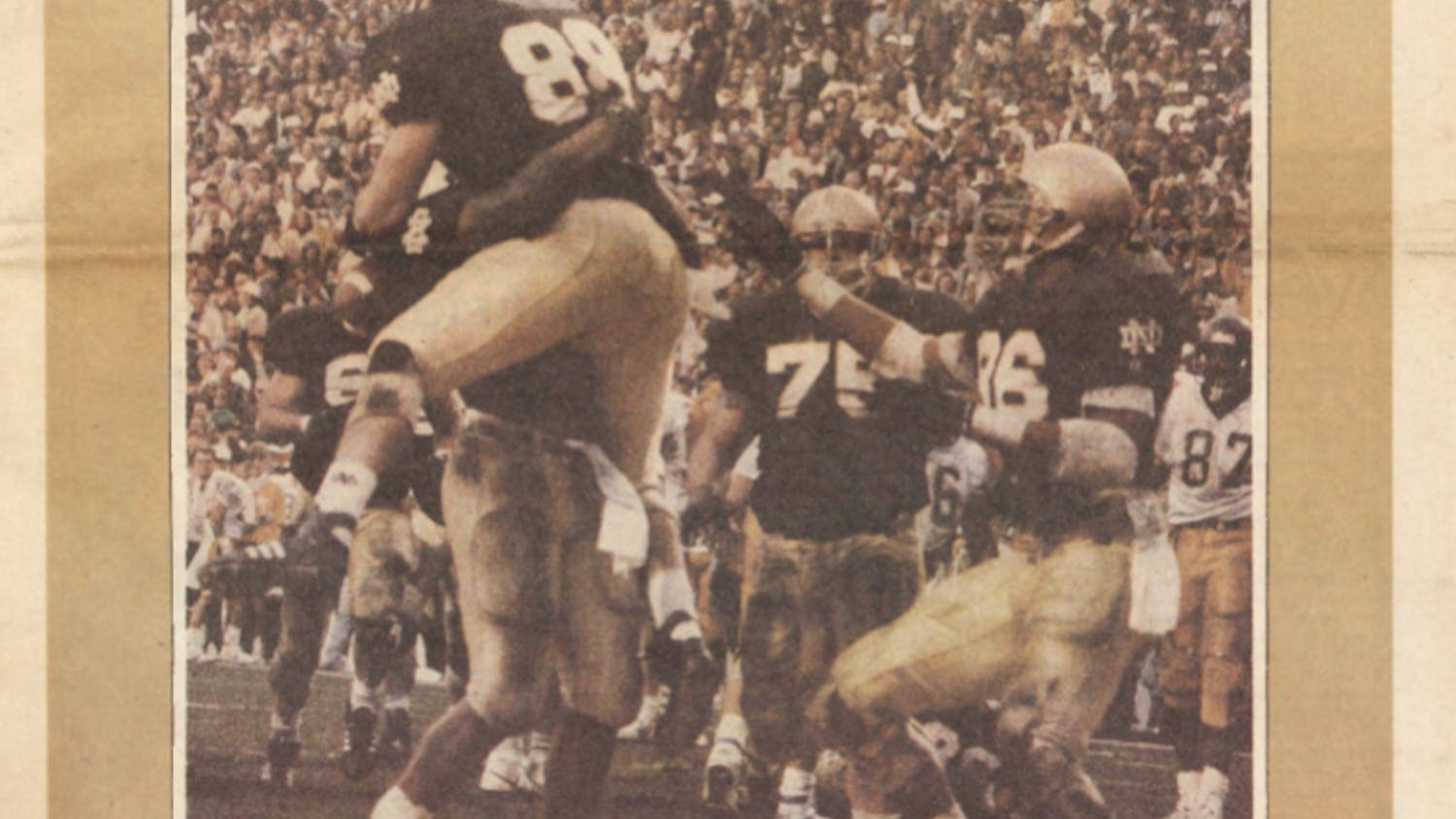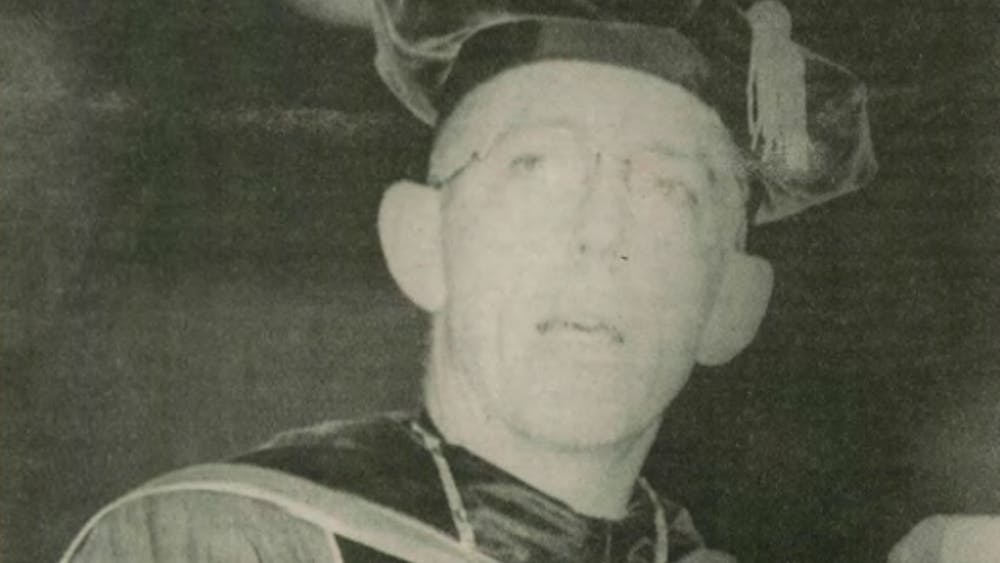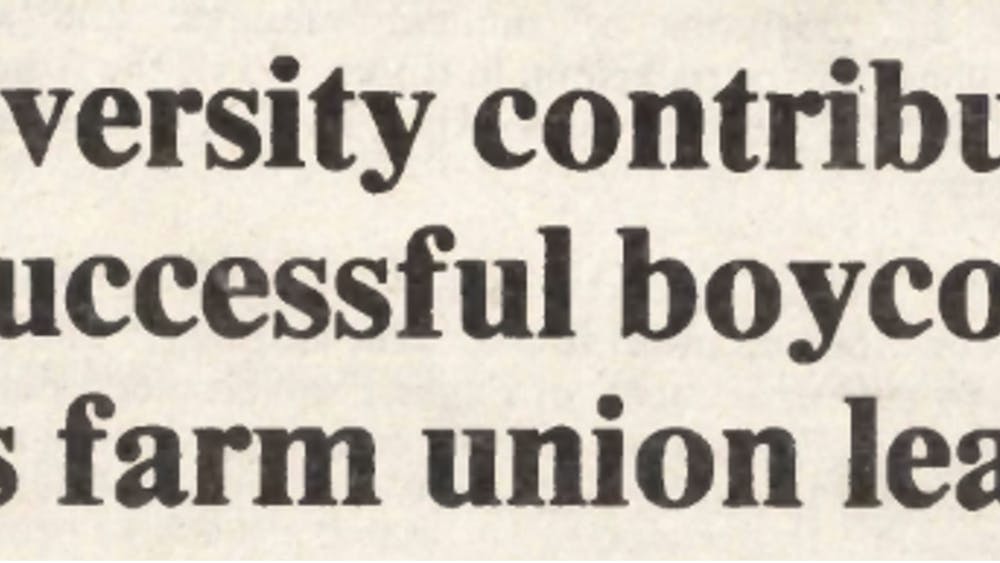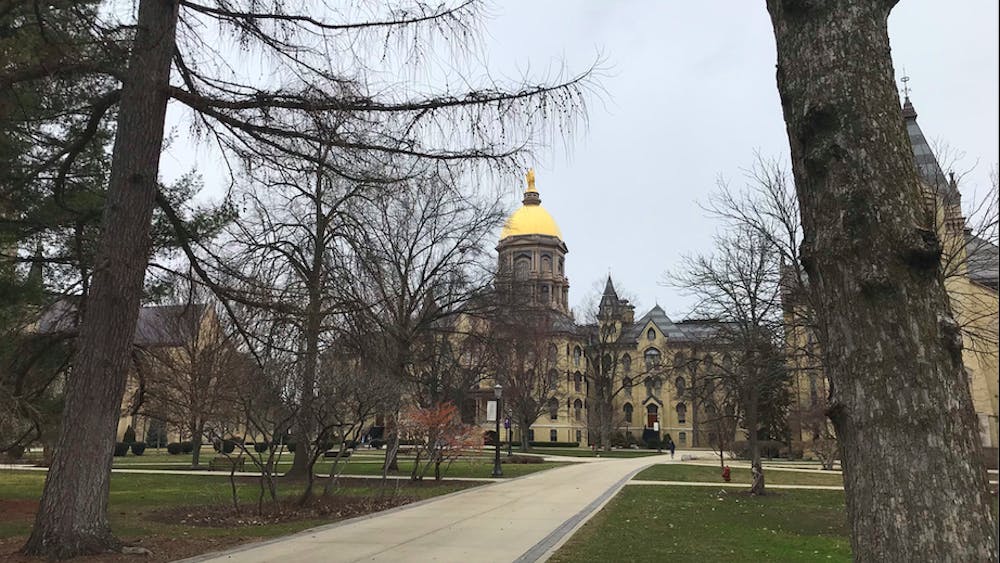This week, the men’s and women’s basketball teams ramp up their seasons at the Joyce Center, their home since 1968. Before the current venue was built, however, Irish basketball played at the Notre Dame Fieldhouse, a structure formerly located next to LaFortune Student Center, and now home to the commemorative Fieldhouse Mall.
Once the Joyce Center (initially called the “Athletics and Convocation Center”) was completed in 1968, the University planned to demolish the then-vacant Fieldhouse. However, a passionate campaign led by an unlikely campus demographic emerged to save the structure. The final years of the Notre Dame Fieldhouse feature a fascinating transformation of the historic building, one last hurrah which added another rich chapter to the Notre Dame history books.
Fieldhouse saved by an unlikely ally
Dec. 6, 1968 | William Luking | Oct. 17, 1969 | Gaetano DeSapio | Nov. 20, 1969 | Paul Gallagher | Nov. 24, 1969 | Paul Gallagher | Dec. 2, 1969 | Tim Treanor | Jan. 9, 1970 | Paul Gallagher | Researched by Avery Polking
Any Notre Dame student who approaches LaFortune Student Center from the northeast crosses a tree-encircled space now known as Fieldhouse Mall. Yet, contrary to its name, no fieldhouse is seen anywhere in the vicinity. Behind this university crossroads is a long and arduous history of the old Notre Dame Fieldhouse and debates over its demolition.
The Notre Dame Fieldhouse was a multi-purpose arena which housed an array of sporting events in the first half of the 20th century. However, sentiments started to stir against its existence in 1969 when the University shared plans for the Fieldhouse’s demolition. Soon, though, a group of passionate art students and faculty as well as others who cherished the tradition of the Fieldhouse as a Notre Dame landmark expressed their objections.

The administration and the newly-formed University Arts Council (UAC) butted heads for three months at the end of 1969 over the question of demolition. Dr. James Fern, Art Department Chair, organized a rally to promote his proposed $1.3 million renovation plan for the Fieldhouse place with hopes of preserving it not as an athletic institution, but a center for the arts.
Those who opposed the Fieldhouse and advocated for its demolition did so for aesthetic reasons, some calling it obsolete, ugly and awkwardly situated. The administration, for one, sought to raze the Fieldhouse because it was an “eyesore and architecturally unsound.”

Notably, the 1969 rally featured an endorsement from Student Body President Phil McKenna as well as a pledge from Fr. Hesburgh himself to do “all he could” to delay the demolition. Hesburgh further announced his admiration for the UAC for their determination in defense of the Fieldhouse.
After three months of social action by the UAC, on January 8, 1970, they received a letter from Fr. Hesburgh declaring a six-month moratorium on the fieldhouse demolition. This constituted victory for the UAC, but Fern’s labor was not over yet. He now had six months to set plans for the new art institute and to raise the funds required.
Twilight in the life of the Notre Dame Fieldhouse
Jan. 12, 1970 | Paul Gallagher | March 13, 1970 | Dan O’Donnel | April 20, 1972 | Observer Staff | July 10, 1975 | Andy Praschak | Nov. 13, 1975 | John Hannan | Researched by Spencer Kelly
While the Notre Dame Fieldhouse is best remembered as a sports venue, the twilight of its life was spent in a reimagined role as a center for arts and culture.
Days after the University granted a six-month demolition moratorium for the Fieldhouse, The Observer reported that renovations would begin promptly; “tomorrow at 4:15,” to be precise.
University Arts Council Chairman Tom Kronk promised that the new Fieldhouse would spark a “cultural renaissance on the Notre Dame campus.”
However, renovations were now estimated at $1.8 million — over $14 million today. Kronk believed funds could be raised, but by March, the Arts Finance Committee reported that “no major contributions” had been received.
At the end of the demolition moratorium, the University extended it indefinitely, keeping the Fieldhouse alive but in a precarious position.

By 1971, the Art Department had settled into the Fieldhouse. Department Chairman Thomas Fern said the building housed classrooms, studios and an art gallery, serving 800 students in total.
However, the Fieldhouse remained unrenovated, and money was still lacking. Fern reported “rather piddling” donations totaling $3,500, nowhere near the millions needed. Still, Fern maintained that the Fieldhouse should stand, saying “[it’s an] educationally valuable space and a viable space.”
The University remained noncommittal on the Fieldhouse’s future.
“You just kind of handle it on a year to year basis,” Fr. Blantz of the Office of Student Affairs said. “As you can see parts of the building are not in good repair. You don’t want to make any long term commitments with a building like that.”
The mid-1970s saw flickers — literal and figurative — of the “cultural renaissance” that Kronk had promised. In 1972, the Fieldhouse hosted a light sculpture exhibit. In strikingly poetic terms, The Observer described how “on the darkness shrouded main floor of the Fieldhouse, [the sculptures] stand out as highlights of brilliant colour [sic] and muted, coloured shadows.”

In 1975, the Fieldhouse held a ceramics workshop, hosting students, teachers and professional potters from around the country.
“This is the first time a workshop of this type has ever been offered in ceramics,” art professor Bill Kremer said.
“I can’t stress enough the convenience of the Fieldhouse for purposes such as this,” Kremer added. “I really hope the University doesn’t continue the discussion of tearing it down.”
Kremer admitted that the Fieldhouse was in decaying condition, noting that “students had to patch the roof.” Kremer was a staunch Fieldhouse supporter, though, citing its abundant space for creativity.
“We give everyone studio space, so they can develop their personality and not have their work thrown in with a mass of others,” Kremer said. “It helps them establish identity.”
Indeed, it seemed that the Fieldhouse itself was a key part of Notre Dame’s identity overall. Whether it was facilitating athletic or artistic endeavors, the Fieldhouse was always a space where the Notre Dame community could come together.
The fall of the Notre Dame Fieldhouse
Oct. 11, 1980 | John McGrath | Feb. 2, 1983 | Margaret Fosmoe | March 1, 1983 | Robert Walsh and Thomas Piernek | Researched by Thomas Dobbs
With the Fieldhouse showing its age by the early 1980s, students shared diverging opinions on its future.
Observer Production Manager John McGrath proposed that the Fieldhouse be converted into a “first-class student center.” McGrath advocated for the conversion of the Fieldhouse due to its “enormous size, its central location on campus and its rich tradition.”
Deirdre Murphy, an architecture student, helped McGrath outline a tentative floor plan. The plan included spaces such as a bowling alley, a 350-500 seat movie theater, a full-size nightclub and coffeehouse, and a multipurpose area for basketball, volleyball, or tennis courts.
McGrath estimated the Fieldhouse renovations at $2.5 million. Repurposing an existing structure, McGrath argued, would be less expensive given the cost of new student dormitories under construction, which he claimed “will cost the university over $3 million” each.
Not all students shared McGrath’s enthusiasm for the potential of the Fieldhouse. Saint Mary's Executive Editor Margaret Fosmoe wrote that “the days of the Fieldhouse are gone.” After planned renovations of the structure fell through in the 1970s, Fosmoe pointed out that the art department occupied the space even as it “continued to decay around them.”

It appears that the University recognized this decay and scheduled the Fieldhouse demolition for the week of spring break of 1983.
Robert Walsh (‘86) and Thomas Piernek outlined the storied history of the Fieldhouse in an ode to the structure in its final week before demolition.
The building functioned as the football locker room for Irish legends George Gipp, Jesse Harper and Knute Rockne. The Fieldhouse also had a rich political history, serving as the venue for a 1935 convocation featuring President Franklin D. Roosevelt and a site for a 1937 “nationwide tour against communism” featuring then-Director of the FBI J. Edgar Hoover.
Walsh and Piernek concluded that the demolition of the Fieldhouse showed that “Notre Dame has more important priorities” than preserving its history. While they predicted that future students would appreciate the fiscal conservatism the University showed in electing against renovating the Fieldhouse, the current students “can find consolation only in the often heard phrase, ‘Notre Dame … not quite the great University it intends to be.’”

Today’s student body would surely reject the assertion that Notre Dame is no longer a “great university.” Still, when Notre Dame demolished the Fieldhouse, this campus lost not just a sporting arena or an art space or a political venue but a piece of its history, now remembered only by a small pillar and a plaque at Fieldhouse Mall.
Contact Spencer Kelly at skelly25@nd.edu
Avery Polking at apolking@nd.edu
Thomas Dobbs at tdobbs@nd.edu









